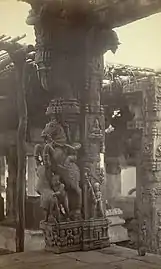Perur Pateeswarar Temple, Coimbatore
Perur Pateeswarar Temple is a Hindu temple dedicated to Lord Shiva located at Perur, in western part of Coimbatore in state of Tamil Nadu in India. The temple was built by Karikala Chola in 2nd century CE.[1] The temple is located on the bank of the Noyyal River and has been patronized by poets like Arunagirinathar and Kachiappa Munivar. Lord Shiva, known as ‘Patteeswarar’, is the presiding deity of this temple together with his consort Parvati, who is known as ‘Pachainayaki’. The deity is believed to be ‘Swayambu Lingam’ (self-emerged).
| Perur Pateeswarar Temple, Coimbatore | |
|---|---|
 Gopuram at the entrance of the temple | |
| Religion | |
| Affiliation | Hinduism |
| District | Coimbatore |
| Deity | Sri Pateeswarara Swamy (Shiva) Sri Pachainayagi Amman (Parvati) |
| Location | |
| Location | Perur, Coimbatore. |
| State | Tamil Nadu |
| Country | India |
 Location in Tamil Nadu | |
| Geographic coordinates | 10°58′33″N 76°54′53″E |
| Architecture | |
| Type | Dravidian architecture |
| Creator | Karikala Chola |
| Completed | 2nd century CE |
| Website | |
| http://www.perurpatteeswarar.tnhrce.in/ | |
Various names for the temple have been used over the years, including, Kamadenupuri, Pattipuri, Adhipuri, Daksha Kailasham, Thavasiddhapuram, Gnanapuram, Kalyanapuram, Pirava Neri Thalam, Pasupathipuram, and Melai Chidambaram.[2]
History
The temple was constructed by order of Karikala Chola during the 2nd century CE, thus making the temple one of the oldest in the state. During the rule of Raja Raja Chola I, Artha Mahal and Maha Mahal were constructed. Additional offerings from the Chola king were made on a regular basis and were noted on the walls of the temple.
The poet Sundarar is believed to have sung the devotional 'Devaram' song in this temple by the 7th century CE. However, while having seven of the 276 temples, Perur Pateeswarar Temple does not appear on the list of Kongu Nadu Padal petra sthalams.
From the 14th to 17th centuries, the kings from different dynasties such as the Hosala dynasty, the Vijayanagara Empire, and Nayakkar Kings have contributed immense donations for the maintenance of the temple. The Kanaga Sabhai was built around the 17th century, by Azhagathiri Nayakkar of Madurai.
By the 18th century CE, the primary deities were renovated, and a Mahal for the 63 Nayanmaars were raised. By the 20th century, the Kalyana Mahal and the front Mahal were constructed, and the tower was renovated as well.[3]
Architecture
Perur Pateeswarar Temple has several gopurams and halls, notably the Kanaka Sabha, which contains a golden statue of Nataraja. The ceiling is covered in a network of stone chains, and the pillars are decorated with carvings of Shiva in his different forms.[4]
There is a Patti Vinayagar shrine, dedicated to Ganesha. The Arasambalavanar Shrine dedicated to Shiva, is believed to be where Shiva performed his Tandav under a peepul tree. There are also statues of Gajasamhara, Virabhadra, Bikshadana, Oordhva Thandava, Saraswati, and Veena. The sacred trees associated with temple are the palm and tamarind trees, called Irava Panai and Pirava Puli.

Culture
Every year, the temple celebrates a classical dance week, typically Bharata Natyam. Dance schools from across the city, including those from foreign cities, perform in front of a large audience.[5] The temple is believed to be one of the places where Shiva performed Ananda Thandavam.[6]
Temple Car Festival
Every year in the month of Panguni, Panguni Uthiram is celebrated. A lavishly constructed temple chariot is paraded through the neighbourhood as part of the celebration.[7]
Seedling Planting Festival
The festival has been celebrated by the farming community, Devendrakula Velalar, since Antiquity along the banks of Noyyal River. The festival is conducted in the month of Aani. The ritual forms a part of Indra festival.[8]
Temple Pond
The Pond is situated opposite of the temple and is used for important rituals such as Panguni Uthiratam.
Temple Lake
Perur Padithurai is 200 meters North from temple and it is situated on the Southern bank of Noyyal River.
Darshan timings
The temple is open on all days. The darshan timings are as below [9]
- Morning : 06:15 to 13:00 IST
- Evening : 16:00 to 20:00 IST
References
- "Arulmigu Patteeswarar Swamy Temple - History". Retrieved 14 December 2016.
- Kumudam Journal; 14.11.2008; Article name : ’படும் துன்பங்கள் பனிபோல் விலகும் பட்டீஸ்வரர் திருவருளால்!’
- "Official Website for Arulmigu Patteeswarar Swamy Temple, Perur, Coimbatore". www.perurpatteeswarar.tnhrce.in. Retrieved 6 September 2017.
- "Rich in history and architecture". The Hindu. 27 May 2005. Archived from the original on 23 January 2008. Retrieved 19 June 2016.
- "Perur Natyanjali". The Hindu. 12 September 2012. Retrieved 19 June 2016.
- V., Meena. Temples in South India. Kanniyakumari: Harikumar Arts. p. 20.
- "பேரூர் பட்டீசுவரர் கோவில் தேரோட்டம்: ஆயிரக்கணக்கான பக்தர்கள் தரிசனம்". 19 March 2019.
- "பேரூர் பட்டீசுவரர் கோவில்". 19 June 2019.
- "Official Website for Arulmigu Patteeswarar Swamy Temple,Perur,Coimbatore". Archived from the original on 16 August 2017. Retrieved 6 September 2017.


.svg.png.webp)